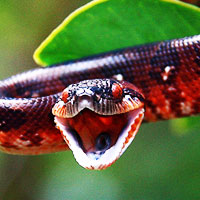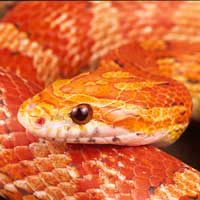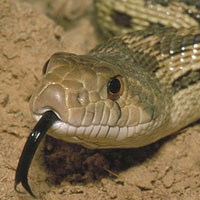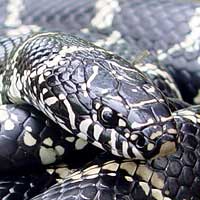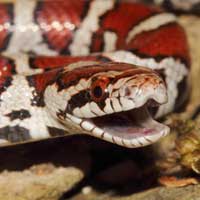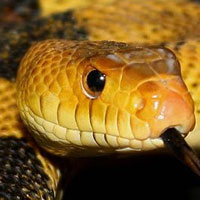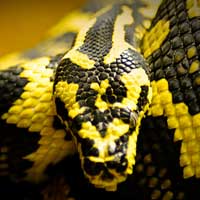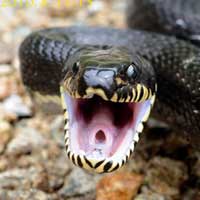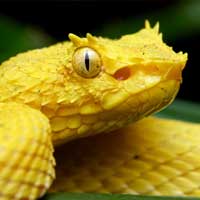All About the Cottonmouth Snake: A Complete Guide
The Cottonmouth (Agkistrodon piscivorus) belongs to the Viperidae family, a group known for its venomous snakes with long, hinged fangs and heat-sensing pits, making it a highly efficient predator in its aquatic and semi-aquatic habitats throughout the southeastern United States.
Scientific Name: Agkistrodon piscivorus
Snake Family: Viperidae
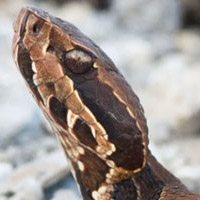
An Overview of the Cottonmouth Snake
The Cottonmouth snake (Agkistrodon piscivorus), also known as the water moccasin, is a highly venomous pit viper found in the southeastern United States. Known for its aquatic lifestyle and distinctive white-lined mouth, this snake plays a critical role in maintaining ecological balance by controlling populations of small mammals, amphibians, and fish.
Where Does the Cottonmouth Live?
The Cottonmouth thrives in wetland environments, making it one of the few venomous snakes with a strong affinity for water. Key habitat features include:
- Geographic Range: Found in the southeastern United States, from Virginia to Texas.
- Preferred Environments: Swamps, marshes, rivers, ponds, and streams.
- Climate: Prefers warm and humid climates, often found in temperate to subtropical regions.
The Cottonmouth’s adaptability to aquatic and semi-aquatic environments allows it to thrive in a variety of conditions. Below is a table summarizing its habitat preferences:
| Habitat Feature | Description |
|---|---|
| Geographic Range | Southeastern United States |
| Preferred Terrain | Wetlands, rivers, and swamps |
| Climate | Warm and humid |
What Does the Cottonmouth Eat?
The Cottonmouth snake is an opportunistic carnivore, consuming a wide variety of prey. Key dietary habits include:
- Primary Prey: Fish, frogs, and other amphibians.
- Occasional Prey: Small mammals, birds, and reptiles.
- Hunting Strategy: Utilizes ambush tactics, relying on its heat-sensing pits to detect prey even in low light.
This versatile diet allows the Cottonmouth to adapt to seasonal changes in prey availability, making it a resilient predator in its ecosystem.
Understanding the Cottonmouth's Behavior
The Cottonmouth is often misunderstood due to its defensive behavior. Key traits include:
- Activity Patterns: Primarily nocturnal but active during the day in cooler months.
- Social Structure: Solitary, except during mating season or basking in groups for thermoregulation.
- Defensive Displays: Opens its mouth wide to show the white interior, hisses, and may coil to deter predators.
While its behavior may appear aggressive, the Cottonmouth typically avoids confrontation unless provoked.
Health and Lifespan of the Cottonmouth
The Cottonmouth has a relatively long lifespan, particularly in captivity. Key health aspects include:
- Lifespan: 10-15 years in the wild, up to 20 years in captivity.
- Common Health Concerns: Parasites and injuries from predators or prey.
- Predators: Birds of prey, alligators, and large mammals are primary threats.
Maintaining clean habitats and proper veterinary care in captivity significantly enhance their health and longevity.
How Does the Cottonmouth Reproduce?
Reproduction in the Cottonmouth follows a seasonal cycle. Key details include:
- Mating Season: Spring and early summer.
- Reproductive Method: Ovoviviparous, giving birth to live young.
- Litter Size: Typically 5-15 offspring.
- Hatchling Behavior: Juveniles are independent and venomous from birth.
The Cottonmouth’s reproductive success ensures its population remains stable in its native habitat.
Safety Tips for Handling the Cottonmouth
Handling the Cottonmouth requires expertise and caution. Key safety measures include:
- Use appropriate tools such as snake hooks and secure containers.
- Wear protective gloves and boots to minimize bite risks.
- Ensure enclosures are escape-proof and mimic natural habitats.
- Keep antivenom accessible and have an emergency plan in place.
Only trained professionals should handle this species to ensure safety and the well-being of the snake.
Disclaimer
The information provided in this article is for educational purposes only. SnakeEstate strongly advises against handling or interacting with venomous snakes, such as the Cottonmouth, unless you are a trained and licensed professional. These snakes pose significant risks, and improper handling can result in serious injury or death. Always adhere to local regulations and prioritize safety when dealing with wildlife.
Other Snakes In This Species
 Asp Viper
Asp Viper Black Mamba
Black Mamba Boomslang
Boomslang Brazilian Coral Snake
Brazilian Coral Snake Bushmaster
Bushmaster Coastal Taipan
Coastal Taipan Common Death Adder
Common Death Adder Common European Adder
Common European Adder Copperhead
Copperhead Coral Snake
Coral Snake Cottonmouth
Cottonmouth Eastern Brown Snake
Eastern Brown Snake Eastern Diamondback Rattlesnake
Eastern Diamondback Rattlesnake Egyptian Cobra
Egyptian Cobra Fer-de-lance
Fer-de-lance Forest Cobra
Forest Cobra Indian Cobra
Indian Cobra Inland Taipan
Inland Taipan Jameson’s Mamba
Jameson’s Mamba King Cobra
King Cobra Lancehead
Lancehead Lataste’s Viper
Lataste’s Viper Malayan Krait
Malayan Krait Mojave Rattlesnake
Mojave Rattlesnake New Guinea Small-eyed Snake
New Guinea Small-eyed Snake Nose-horned Viper
Nose-horned Viper Puff Adder
Puff Adder Russell’s Viper
Russell’s Viper Saw-scaled Viper
Saw-scaled Viper Solomon Island Coral Snake
Solomon Island Coral Snake South American Rattlesnake
South American Rattlesnake Tiger Snake
Tiger Snake Western Diamondback Rattlesnake
Western Diamondback Rattlesnake
